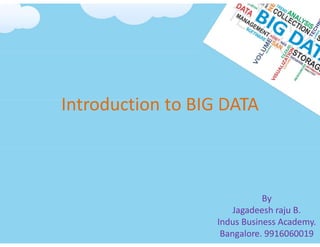INTRODUCTION TO BIGDATA
- 1. Introduction to BIG DATA By Jagadeesh raju B. Indus Business Academy. Bangalore. 9916060019
- 2. WHAT IS DBMS ? It stands for Database Management System. ? Contains all the information about the enterprise. ? Collection of interrelated data. ? It is centralized database management. ? Persistent storage management. ? Transaction management.
- 3. Loopholes in DBMS ? Difficult to handle huge data. ? Supports only structured form of data. ? Always stores data in table format. ? High level query and data manipulation language. ? Interaction with the other levels are difficult.
- 4. WHAT IS BIG DATA ? As the name itself it is a huge data(T.B-P.B). ? Data sets are too large and complex. ? Very complex to manipulate or interrogate. ? Standard methods and tools are not enough. ? Big data spans three dimensions. ? Volume, velocity, variety.
- 5. How it is creating. ? At every end of 59th second the following data is generating.
- 6. Why big data should matter? ? Determine root causes for failures. ? Determine issues and defects in real time. ? Potentially saving billions of dollars annually. ? To analyze millions of SKUs to determine price. ? Recalculate entire risk in minutes. ? Quickly identify the customer who matters most.
- 7. Application for Big data ? Smarter health care. ? Multi channel sales. ? Social media. ? Telecom. ? Log analysis. ? Trading analysis. ? Manufacturing.
- 8. Big players in Big data ? Google. ? Facebook. ? Flipkart. ? Acenture. ? Infosys. ? Cognizant. ? Mu sigma.









